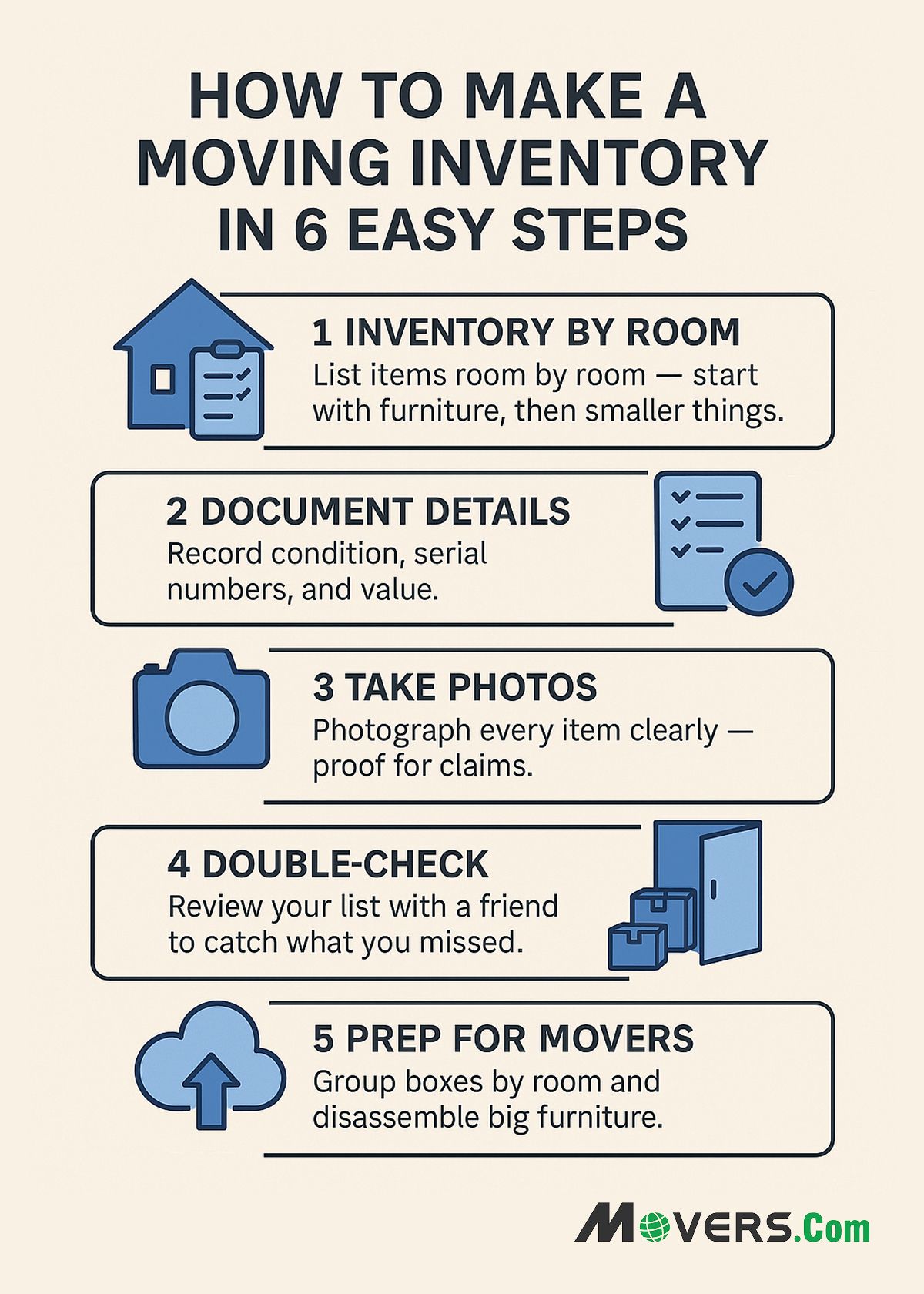It's always prudent to create a moving inventory when you relocate.
If your personal property is damaged or stolen, you won't receive reimbursement for your belongings unless you have proof of its condition beforehand.
Don't make it a long and tedious process — use these tips to make a moving inventory in just six steps!
Create Separate Inventory for Each Room of Your House
Keep a separate sheet of inventory per room. Start at the top (attic) or the bottom (basement), recording everything in the space before moving on to the next room. Do not jump around!
-
Start with major items, like furniture or appliances
-
Then move to smaller items, like end tables and lamps
-
Finally, take note of things hidden in shelves and drawers
While you don't have to record every item in a set (for example, each book by name), be specific about any super valuable items such as artwork or antiques.
If you don't feel comfortable with movers touching these items while moving, keep them with you instead.
Document All Important Details About Your Inventory
Include several columns in your written inventory, such as:
-
Current condition
-
Market value
-
Make, model, serial number
-
If you still have the receipt and warranty paperwork
-
What room it's being moved from
-
What new room you would like it to be placed in
Take Photos as Back Up
Take pictures of all items as soon as you add them into the moving inventory.
Capture each item separately with good lighting and a clear background.
This photographic evidence is the best way to prove the condition of items before the move.
Visual evidence is hard to dispute.
TIP: For anything new and unopened, save the receipt and photograph the unopened box.
Double Check All Items and Make Sure You Did Not Miss Anything
After you finish the whole house, go back through every room.
This lets you keep a check of certain items that you might forgot to list entirely.
Check that you included any brand-new furniture and appliances in your moving list.
Once you double check, ask someone else to read your household inventory.
It won't hurt to have another pair of eyes check the document's clarity and that all belongings have been included.
TIP: To save time, ask the person double checking your work to read the inventory aloud. And as they mention an item, pack it up.
Move Everything to The First Floor Before the Movers Arrive
Once you've created your moving inventory, you can bring everything down (or up) to your first floor.
Group the items by room and leave them close enough to the door to minimize handling and reduce stair fees.
Disassemble beds and tables before the movers arrive.
Back Up Your Written Inventory with a Digital One
You should always back up your physical inventory by recording the information in a digital moving inventory.
Digital moving inventories are easier to create and more convenient to access.
You can use an app on your smartphone or make a shareable Google doc.
Other things to consider:
-
Save the inventory in cloud storage for easy access
-
File a physical copy of the inventory with your insurance company
-
Place another physical copy of the inventory in a secure or locked location
What Are the Benefits of Creating a Moving Inventory?
Depending on your homeowner's insurance policy, you may be required to submit a list of your damaged or stolen goods to claim a total loss of your possessions.
Additionally, you would need to include the estimated value of your goods along with a household inventory.
Your insurance plan may cover replacement cost on lost property.
If so, you receive payment based on the current value of your lost items without considering the original item's initial cost.
However, most insurance companies prefer to pay the actual cash value (ACV), or market value, which is the cost to replace the item minus depreciation.
Homeowner's insurance policies vary by company, so make sure to investigate what your policy will cover and how they define their coverage terms.
Conclusion
Creating a home moving inventory is a simple yet effective way of keeping track of your belongings.
Creating separate document for each room lets you gather key details, and backing them up provides an extra layer of protection.
Having a moving inventory list also makes insurance claims easier in case of items lost or damaged.
At movers.com, our experts can guide you on how to efficiently keep a track of your inventory while moving.
Visit us to know more and get a free quote.
